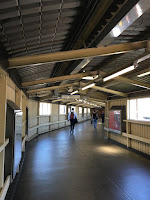One of the most interesting aspects of the London Underground is over eleven miles away from the city centre at Hounslow. Hounslow is situated in south west London and has had an interesting history with its London Underground stations. Four stations now serve the area, but in the past more stations have severed the area.
The diagram below gives a rough, but to scale, overview of the history of stations in the area. Although these stations are now all served by the Piccadilly line, when the stations initially opened, they were served by the Metropolitan District Railway, which would become the District line. Between 1933 and 1964 the stations that were open, were served by both the Piccadilly line and District line. The Piccadilly line terminated at Northfields until March 1933, when Piccadilly line services were extended to Hounslow West. The District line stopped running services this far in October 1964.
1883 - The Metropolitan District Railway reaches Hounslow Town
Osterley & Spring Grove and the terminating Hounslow Town both opened 1st May 1883, interestingly neither of these stations are now open. However, there are differing accounts as to what the original name of Osterley & Spring Grove was called? With some referring to the station as Osterley Park & Spring Grove, but I will stick with just Osterley & Spring Grove. This was important as at some stations in London, the station was referred as just Osterley.
1884 - Hounslow Barracks opens
 |
| The station building built in 1931, 3rd June 2017 |
When Hounslow Barracks, which later became Hounslow West, opened in 1884. Both Hounslow Barracks and Hounslow Town were terminating stations for the Metropolitan District Railway. The initial station was gradually closed in 1931 once the new station building was opened.
1886 - Hounslow Town closes and Heston & Hounslow opens
 |
| Platforms at Heston & Hounslow, now Hounslow Central, 3rd June 2017 |
Hounslow Town closed on the 31st March 1886, but Heston & Hounslow opened one day later on 1st April 1886. Heston & Hounslow is still situated at the original site, but was renamed Hounslow Central. The current station building was opened in October 1912.
1903 - Hounslow Town reopens
It decided to reopen the track towards Hounslow Town, again making both Hounslow Barracks and Hounslow Town terminating stations for the Metropolitan District Railway.
1905 - A loop of track opens from Hounslow Town to Heston & Hounslow
When the loop of track opened in 1905, trains no longer terminated at Hounslow Town. The loop was originally opened as the line was electrified. Trains from Osterley & Spring Grove would run to Hounslow Town, reverse out, and then head to Heston & Hounslow and Hounslow Barracks.
1909 - Hounslow Town is relocated
 |
| The original Hounslow Town, 3rd June 2017 |
On the 1st May 1909 the original Hounslow Town closed, as did the loop of track to Hounslow Central. A day later on the 2nd May 1909, the new Hounslow Town station opened allowing Metropolitan District Railway services to directly go to Hounslow Barracks. The remains of Hounslow Town are still visible, as the bus station at Hounslow is the old Hounslow Town station building.
1925 - Renaming
On the 1st December 1925, Hounslow Barracks was renamed Hounslow West, Heston & Hounslow was renamed Hounslow Central, and Hounslow Town was renamed Hounslow East. In 1933 the Piccadilly line extended from Northfields to Hounslow West, meaning Hounslow West, Hounslow Central, Hounslow East, and briefly Osterley & Spring Grove, were now served by both the Piccadilly line and District line. Boston Manor was also now served by both lines, but is not on this diagram.
1934 - Osterley & Spring Grove closes and Osterley opens
 |
| Osterley roundel, 3rd June 2017 |
Osterley & Spring Grove is now a book shop, but the platforms are still in place. If you want to see the old station, you can, as the platforms are 300m east from Osterley station. Osterley has always had the same name.
1964 - The District Line retreats
On 9th October 1964, the District line stopped serving the branch out towards Hounslow. There are ongoing talks to rethink installing District line services towards Hounslow, and onto Heathrow. However, with Crossrail coming to Heathrow in the near future, I think it is highly unlikely TFL will extend the District line. The District line is complicated enough for tourists, without having another branch.
1975 - Hounslow West is relocated as the Piccadilly line extends to Hatton Cross
 |
| The walk between the platforms and the station building at Hounslow West, 3rd June 2017 |
The final change to occur in this area is the relocation of Hounslow West as the Piccadilly line extended to Hatton Cross. Due to the location of the platforms at Hounslow West, if they were to extend the Piccadilly line to Hatton Cross from the existing location, they would have to demolish numerous houses. As a result it was decided to locate new platforms a short distance away so houses did not have to be demolished. However, the station building at Hounslow West now is the same one built in the 30s, hence the considerable work from the platforms to the station building.
For train and London Underground enthusiasts, coming to Hounslow is a must. It is exciting to walk the area and still see clues to Hounslow's past. Please follow tubespottingdan on Instagram and Twitter for more updates, photos and cool facts.







